October 6. LALIBELA "A Labyrinth of Rock-hewn Churches" (continued) We rounded the back wall behind Bet Maryam and passed the Tomb of Adam. A long pathway led away from the cluster of nothern churches, back to the main road. The map in our book was unclear so we had a hard time finding the path to the next church on our own. The local people didn't act like they wanted to help us but one person finally pointed us in the right direction. This church stood off on its own, apart from both the northern and eastern clusters. A long pathway led away from the road and it was lined up with beggars, just one after another. At the end of the pathway was a small bridge and from there we could see the cross-shaped roof of Bet Giyorgis. There wasn't a metal roof over this church which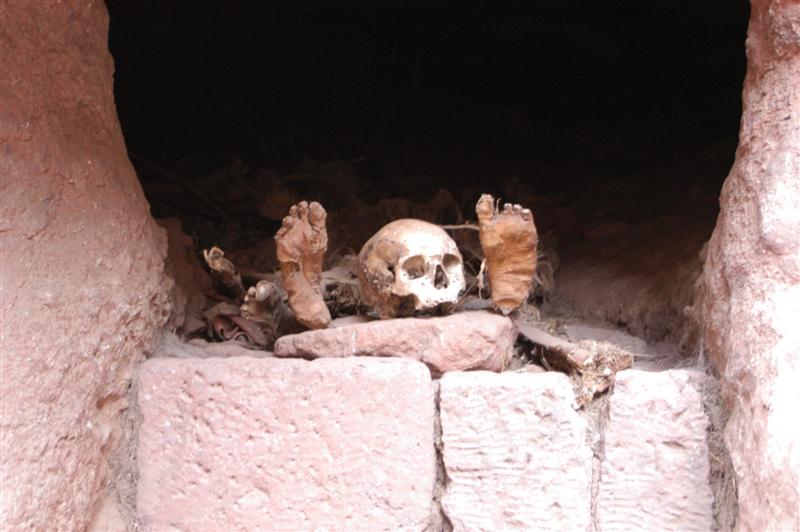  made its unique shape all the more impressive. A group of teenager boys tried to stop us as we came up to the bridge. "Where is your ticket?!", they demanded. It was clear that they weren't the ticket collectors so we didn't stop. As we kept walking they yelled at us "You are very bad people and you visit such a holy place!" The ticket checker was a bit farther along and after showing him our ticket we turned back to this group of teenagers and pointed to the ticket checker. made its unique shape all the more impressive. A group of teenager boys tried to stop us as we came up to the bridge. "Where is your ticket?!", they demanded. It was clear that they weren't the ticket collectors so we didn't stop. As we kept walking they yelled at us "You are very bad people and you visit such a holy place!" The ticket checker was a bit farther along and after showing him our ticket we turned back to this group of teenagers and pointed to the ticket checker.
Bet Giyorgis supposedly represented the apex of rock-hewn churches. The whole church was built out in a cross shape, like the shape of a Greek cross with all side the same length. It is more recent but still included some Aksumite influences, like all of the rock-hewn churches in Lalibela. Instead of a stairway, a long pathway swooped down the far side of the church. Partway down we found the supposed hoof prints of St. George's horse, stamped into the wall. According to legend, Ethiopia's patron saint paid King Lalibela a visit after he built all of his rock-hewn churches. Apparently the saint wasn't pleased that none of the churches were dedicated to him so King Lalibela promised to build him the most beautiful church of all. Inside, the church was carved out like all of the others but was very tall and narrow. As soon as we walked inside the priest requested a 10birr "donation" (really a tip), which didn't seem optional. We paid it but I asked him to step outside so I could photograph him in the natural light. While I found it rude for people to visit religious places and not offer a donation, I didn't feel as obligated when I had already paid for a ticket up front. Tipping people for their helpful attention is also appropriate but the situation at Lalibela seemed to be growing into quite a commercial undertaking. It wasn't so much the amount, even though that was getting high by Ethiopian standards, but it was the way in which it was done. It sort of demeaned the religious importance of the place in my mind. Everything is culturally relative but our experience at the monasteries on Lake Tana had been different, which led me to believe that it was tourism that was changing these places. It made me sad.
From Bet Giyorgis we headed to the eastern cluster of churches. It was getting late but we weren't alone. We ran into a m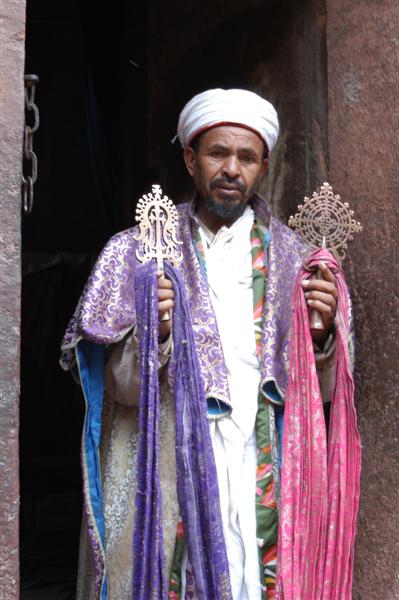 an from New York that Rob talked to at an from New York that Rob talked to at  the airport. The trail to the eastern cluster wasn't marked but someone kindly showed us the way. The first church we visited was Bet Gabriel-Rafael. A bridge crossed over a deep trench to the entrance, which was at the top of the wall. The layout of this church was different than the others and some thought that it was once used as residence for the royal family. Instead of being hollowed out from the bottom of the trench it was a smaller chapel on the top, kind of like an island or a house with a moat around it. We were both feeling tired at this point. The weather had been pretty good all afternoon but was warm out. I was sweating heavily and eternally grateful for my fly whisk. Our flight didn't leave until the following afternoon but we were determined to get through the churches by the end of the day. If we didn't we had a feeling that we wouldn't make it back. the airport. The trail to the eastern cluster wasn't marked but someone kindly showed us the way. The first church we visited was Bet Gabriel-Rafael. A bridge crossed over a deep trench to the entrance, which was at the top of the wall. The layout of this church was different than the others and some thought that it was once used as residence for the royal family. Instead of being hollowed out from the bottom of the trench it was a smaller chapel on the top, kind of like an island or a house with a moat around it. We were both feeling tired at this point. The weather had been pretty good all afternoon but was warm out. I was sweating heavily and eternally grateful for my fly whisk. Our flight didn't leave until the following afternoon but we were determined to get through the churches by the end of the day. If we didn't we had a feeling that we wouldn't make it back.
Inside Bet Gabriel-Rafael a kind priest showed us a lovely illuminated manuscript but there wasn't much else to see. Supposedly a tunnel led from this monastery to a place called Arogi Bethlehem, a bakery for making holy bread, but there wasn't any signage or anybody around to point us in the right direction so we felt our way around the rest of the monasteries the best that we could. It was more of a labyrinth than the northern cluster. We could see the tops of the monasteries but the route down into them wasn't as obvious. We passed a man who was praying and he pointed us towards a set of stairs that got us down to the base level but we couldn't find our way from there. A large door looked like the entrance to Bet Amanuel but it was locked. It was getting late in the day but the monasteries weren't supposed to be closed yet so we kept looking. We followed the pathway in both directions but came up with nothing. The guy from New York passed us with his smug guide and disappeared into an overhang. That appeared to be the way but we couldn't follow without a flashlight. Instead we returned to the top and walked around the edge of the Bet Amanuel monastery until an attendant, a designated shoe watcher we suspected, in the courtyard saw us. We shrugged to express our confusion so he pointed us to a narrow trail and motioned that we need to go down and around. It wasn't entirely clear but we started down the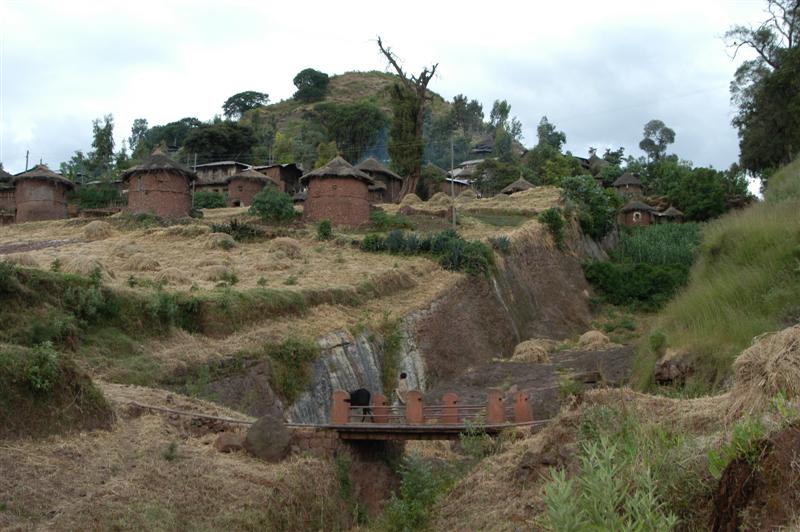 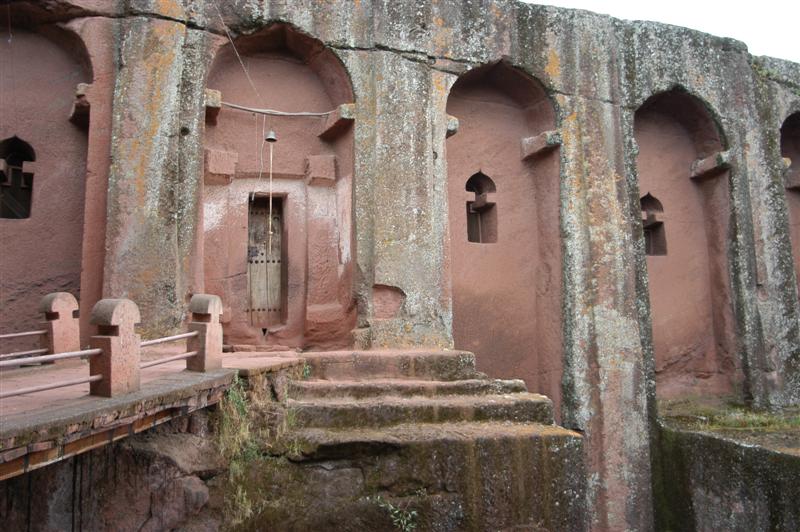 pathway and soon found that it led to a kind of hallway that opened up into the courtyard of Bet Merkorios. The attendant came to meet us, which was very nice, and pointed to us the entrance to Bet Merkorios and then indicated how to get to Bet Amanuel from there. He didn't speak any English so this was all done through gestures. pathway and soon found that it led to a kind of hallway that opened up into the courtyard of Bet Merkorios. The attendant came to meet us, which was very nice, and pointed to us the entrance to Bet Merkorios and then indicated how to get to Bet Amanuel from there. He didn't speak any English so this was all done through gestures.
Bet Merkorios was a simple chapel that was thought to have once been a prison. It was carved into the earth and wasn't very large inside. The main attraction was its frescos and a 16th century painting. A priest greeted us when we entered and commented that we didn't have a guide. We nodded and sat quietly to take in the surrounding imagery and leaving a donation before moving on. From there a pathway led through another tunnel/cave and out to a short set of stairs. The stairs clung to the wall of the courtyard in front of Bet Amanuel. In terms of grandeur this was the most impressive facade that we had seen. Bet Giyorgis stood out with its unique shape but this was the most beautiful, even the metal roof didn't detract from its finely carved exterior In the courtyard we met the attendant who had given us directions. He smiled and directed us to the church entrance.
Bet Amanuel was in a typically Aksumite style which was rather austere, with sharp lines and recessed walls. While the church was monolithic from the outside the interior was more compact, the back of the church being restricted. We took a brief rest inside. It had been more of an adventure to find this church than we had expected. The guy from New York arrived at about the same time and I heard his guide make reference to the symbolism of three present in the church. The building was three stories tall and the number of windows was a multiple of three, all in reference to the trinity of course. It definitely would have been better to have hired a guide for these churches. It seemed that they were moving at nearly 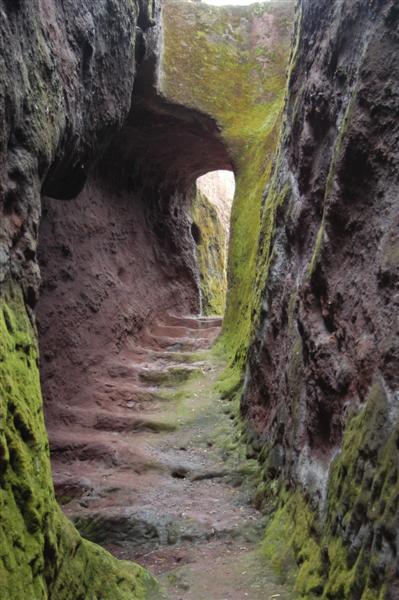 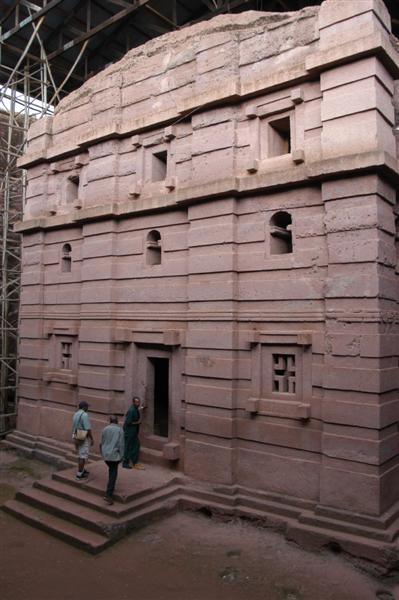 the same pace as we were anyway. Normally that would have been much too fast for us but it appeared that having a guide had benefits that outweighed the negatives. Solomon, from our hotel, wanted to charge us $20 for the day, which seemed like an awful lot but the guides queued up at the gate were less. Some didn't seem to speak English very well but just to have someone there to get the artifacts brought out and to show you the way into the monasteries would have made the expense worthwhile. The priest inside Bet Amanuel brought out another large cross for the guided groups but we just stayed back, having lost interest in the politics of being tourists at Lalibela. the same pace as we were anyway. Normally that would have been much too fast for us but it appeared that having a guide had benefits that outweighed the negatives. Solomon, from our hotel, wanted to charge us $20 for the day, which seemed like an awful lot but the guides queued up at the gate were less. Some didn't seem to speak English very well but just to have someone there to get the artifacts brought out and to show you the way into the monasteries would have made the expense worthwhile. The priest inside Bet Amanuel brought out another large cross for the guided groups but we just stayed back, having lost interest in the politics of being tourists at Lalibela.
When we came out of the church we tipped the attendant for his help with directions and watching our shoes. He seemed very appreciative and continued to guide us around the courtyard, pointing out the graves that were set into the walls, just skeletons exposed to the elements but quite a privileged place to have been laid to rest. Our guide led us out the back of the courtyard and pointed us down another trail. Apparently we had one more church to see and we hadn't even realized. He had earned himself another tip. The trail led along the outside wall of Bet Amanuel but went deeper into a small ravine. At the bottom the trail narrowed to pass through a tall tunnel chiseled through the rock. Eventually we came to the large courtyard of Bet Abba Libanos.
Bet Abba Libanos was an exception in Lalibela. Carved into the side of a wall, only the ceiling was attached to the overhead rock. The facade, unfortunately covered in scaffolding for restoration work, was made of stone bricks. It also expressed an Aksumite style but was rather small when compared to Bet Amanuel. From inside the church a small door led to the back. The church was built within a cave with the rest of the cave surrounding the outside of the church. There were burial places in the walls there as well. Returning through the inside of the church we thanked the priest and commented on the fine cross he had hanging from his neck. It was about seven inches long and was held in a leather holder so it could be hung around the neck or removed and used by the priest. He smiled and said "How much?" Rob thinks he was just kidding but I had grown too cynical. I think if we had made an offer he might have sold us that cross right off is his neck. 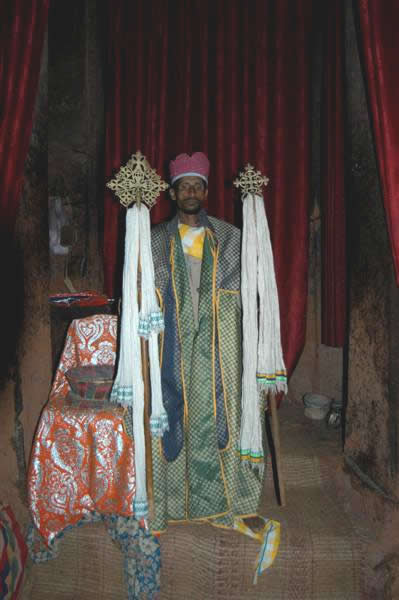 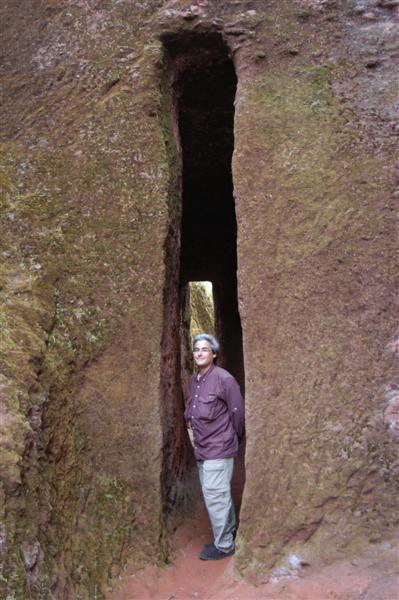
That was it, we were finally through all of the churches and they were starting to close as we left. A trail led through the surrounding homes to the main road. Several children were encouraged to chase after us and beg. They were incredibly persistent. As soon as we lost one we picked up another. It made me feel so sad for them but we had a pretty firm policy of not encouraging begging from children. It just made the parents send them after tourists that much more while neglecting their education.
After a rest in our hotel room we returned to the Hotel Roha for dinner. It was our two year anniversary so we splurged on a three course dinner and a bottle of wine. It wasn't as glamorous as it might sound but it was it was a big deal for us. Rob even shaved. |

